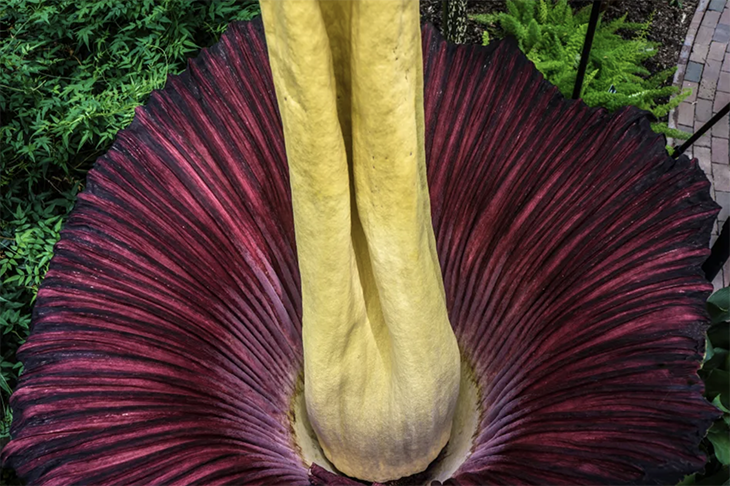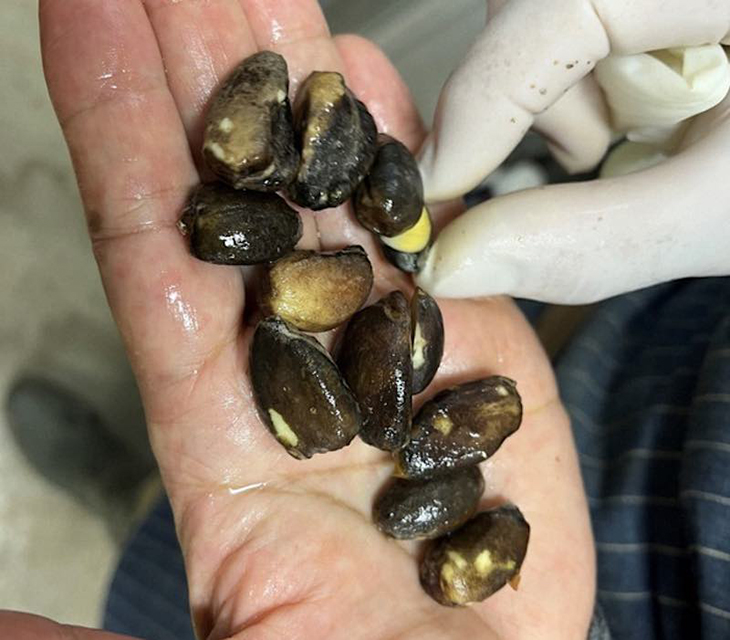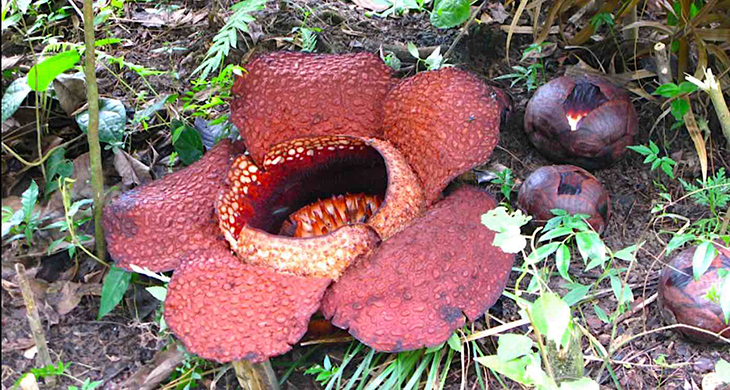
In a remarkable twist of fate, a Japanese botanical garden experienced the simultaneous blooming of two distinct species of ‘corpse flowers,’ known scientifically as Amorphophallus titanum or titan arums. This extraordinary event provided a unique opportunity for the two flowers to naturally cross-pollinate.
This stroke of fortune resulted in the fruition of one of the corpse flowers, yielding a substantial harvest of 736 seeds crucial for the conservation of this fascinating botanical marvel. While the more renowned corpse flower is often associated with the Rafflesia genus, these titan arums, found in the rainforests of the Indonesian islands of Sumatra and Borneo, boast similar captivating qualities.
These enormous flowers, which sporadically bloom at irregular intervals spanning years, are housed in the Tsukuba Botanical Gardens, part of Japan’s National Museum of Nature and Science. Among the ten titan arums in the collection, only one had bloomed since 2012. Upon emerging into the sunlight, the world’s largest flower emits a chemical scent, not to attract typical nectar feeders, but rather carrion flies.
This distinctive odor, likened to everything from decaying meat to rancid garlic, complicates the task of the Tsukuba Botanical Gardens’ workers in collecting pollen from these giant flowers. Despite numerous artificial attempts at pollination in captivity, none have succeeded, and natural pollination had not occurred until this fortuitous simultaneous blooming event. The intricate reproductive mechanisms of these titan arums continue to present a captivating challenge in botanical conservation efforts.
“We don’t know why, whether pollination can’t occur with pollen from this one plant, or whether pollen has a limited shelf life,” Head researcher Chie Tsutsumi said when she spoke to the Mainichi.

In the month of May this year, a noteworthy event unfolded in the gardens as a female plant unexpectedly blossomed eight days prior to a male plant displaying a notably larger bloom. Recognizing the fortuitous timing, the horticulturalists swiftly harvested pollen from the initial bloom and meticulously applied it to pollinate the second one.
The delicate process of transferring the pollen onto the female plant consumed approximately an hour, during which the staff endured the pungent odor that permeated the air. According to reports from the Mainichi, this distinctive fragrance proved challenging to remove from their clothing.
The culmination of their efforts became apparent in November when the pollinated plant fruited, yielding a substantial harvest of persimmon-like seeds. The dedicated team meticulously gathered seeds from over 700 small red fruits, laying the foundation for an extensive cultivation endeavor.
“It’s a difficult plant to cultivate, but I’m looking forward to growing it from seed,” said Tsutsumi.
In February 2022, the endeavors of Sofi Mursidawati, a Ph.D. holder in agriculture at the Bogor Botanical Gardens, gained attention. She embarked on a groundbreaking initiative to establish the world’s inaugural nursery for the renowned corpse flower, Rafflesia arnoldii, which exhibits a distinctive nature compared to the titan arum.
Rafflesia, characterized as a parasitic specimen, lacks leaves, roots, or stems, boasting only a colossal, one-meter-long, 20-pound blossom. In stark contrast, the titan arum features an extensive root system, constituting the largest single corm or tuber on Earth, with a staggering weight exceeding 200 pounds. Mursidawati’s pioneering work delves into the unique challenges posed by the cultivation of Rafflesia arnoldii, shedding light on the intriguing differences between these two extraordinary floral species.

With seeds resembling minuscule grains of sawdust, the Tetrastygma genus experiences a unique life cycle as pollinated flowers transform into colossal cabbage-sized bulbs over several months. However, these botanical oddities transcend conventional notions of plants.
Diverging from the genetic blueprint for photosynthesis millions of years ago, the Rafflesia genus has become entirely reliant on its host for sustenance. Unlike the majority of flowers equipped with specialized structures for pollination, Rafflesia blooms exhibit sexual monomorphism. This means that, despite investing an entire year in the growth of a single flower, successful reproduction is contingent upon the presence of a counterpart flower of the opposite sex within the same territory. The allure of the carrion flies, drawn to the scent of decay emanating from its nectar, plays a crucial role in orchestrating this intricate reproductive dance.
What are your thoughts? Please comment below and share this news!
True Activist / Report a typo


